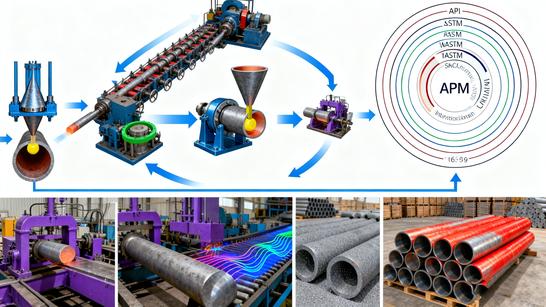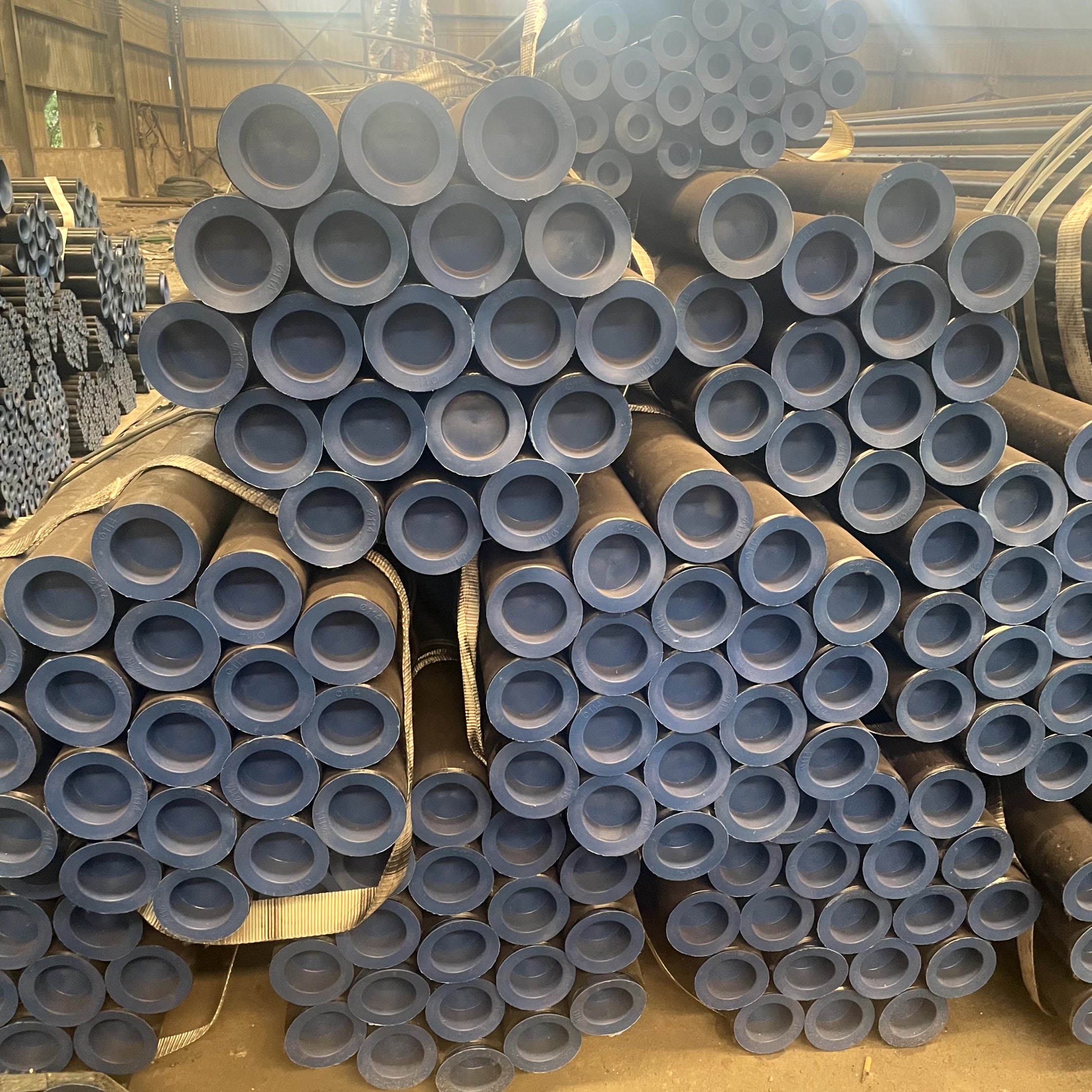In high-end manufacturing sectors like automotive, hydraulic engineering, and precision machinery, the demand for seamless tubes with strict dimensional accuracy, superior surface quality, and reliable mechanical performance is growing rapidly. Products such as cold-drawn seamless tubes, precision seamless steel tubes, hydraulic seamless tubes, high-accuracy seamless pipes, bright annealed seamless tubes, and automotive seamless steel pipes have become core components supporting industrial upgrading. This guide systematically explains their definitions, key characteristics, standards, selection methods, and application scenarios, helping engineers and procurement professionals make informed decisions.
1. Core Definitions: Understanding Precision Seamless Tube Variants
Each type of precision seamless tube is designed for specific functional needs, with unique manufacturing processes and performance advantages. Clarifying their definitions is the first step in rational application.
1.1 Cold-Drawn Seamless Tube
A cold-drawn seamless tube is produced by drawing a hot-rolled seamless tube through a die at room temperature without additional heating. This process eliminates internal defects (e.g., shrinkage holes) in the tube and significantly improves dimensional precision. Its key features include:
- Tighter dimensional tolerance (outer diameter tolerance ±0.1mm, wall thickness tolerance ±5%).
- Smooth surface finish (Ra ≤ 1.6μm), reducing the need for secondary processing.
- Higher mechanical strength (tensile strength increased by 15–20% compared to hot-rolled tubes) due to work hardening.
1.2 Precision Seamless Steel Tube
Precision seamless steel tubes are a high-end subset of seamless tubes, emphasizing extreme dimensional accuracy and surface quality. They are typically manufactured via cold drawing or cold rolling, with strict control over:
- Dimensional parameters: Ovality ≤ 0.5mm/m, straightness ≤ 1mm/m.
- Surface defects: No scratches, pits, or oxide scales (often requiring bright annealing for further improvement).
- Material uniformity: Microstructure homogeneity ensured by multi-pass drawing and intermediate heat treatment.
1.3 Hydraulic Seamless Tube
Hydraulic seamless tubes are specialized for hydraulic systems (e.g., hydraulic cylinders, pipelines), where they must withstand high pressure and frequent pressure cycles. Key requirements include:
- High pressure resistance: Designed for working pressures of 10–63 MPa (some ultra-high-pressure models up to 100 MPa).
- Low internal friction: Smooth inner surface (Ra ≤ 0.8μm) to minimize fluid flow resistance and extend hydraulic component life.
- Strict non-destructive testing (NDT) to detect internal cracks that could cause pressure leakage.
1.4 High-Accuracy Seamless Pipe
High-accuracy seamless pipes focus on ultra-precise dimensional control for applications like precision machinery spindles and aerospace components. They exceed the tolerance standards of ordinary precision tubes, with:
- Outer diameter tolerance up to ±0.05mm.
- Wall thickness variation ≤ 3% of the nominal thickness.
- Customizable length accuracy (cutting error ≤ 0.1mm for short-length pipes).
1.5 Bright Annealed Seamless Tube
Bright annealed seamless tubes undergo a bright annealing process (heating in a protective atmosphere like hydrogen or nitrogen) after cold working. This process achieves:
- Bright, oxide-free surface (Ra ≤ 0.4μm), eliminating the need for pickling or polishing.
- Softened material (hardness reduced by 30–40%), improving formability for bending or flanging.
- Enhanced corrosion resistance due to the uniform protective oxide film formed during annealing.
1.6 Automotive Seamless Steel Pipe
Automotive seamless steel pipes are tailored for automotive powertrains, chassis, and braking systems. They prioritize:
- Lightweight design: Thin-walled structures (wall thickness 1.5–5mm) with high strength-to-weight ratio.
- Fatigue resistance: Able to withstand 10^6+ cyclic loads (critical for suspension and transmission components).
- Compliance with automotive industry standards (e.g., ISO 11942) for material consistency and safety.
2. Key Standards and Performance Requirements
International and industry standards ensure the quality and interchangeability of precision seamless tubes. Below are the most influential standards and their core requirements:
2.1 Global General Standards
| Standard | Applicable Products | Core Requirements |
|---|---|---|
| ASTM A1011 | Cold-drawn, precision seamless tubes | Specifies chemical composition (e.g., C ≤ 0.25% for low-carbon grades) and mechanical properties (minimum yield strength 240 MPa). |
| EN 10305-1 | Hydraulic, automotive seamless tubes | Mandates pressure testing (1.5× design pressure for 10 seconds) and surface finish (Ra ≤ 1.6μm for hydraulic tubes). |
| ISO 4394-1 | High-accuracy seamless pipes | Defines ultra-tight tolerances (outer diameter ±0.07mm, wall thickness ±4%) and straightness (≤ 0.5mm/m). |
2.2 Industry-Specific Standards
- Automotive: ISO 11942 (for fuel injection pipes) requires hydrogen embrittlement testing to prevent cracking under high pressure; SAE J524 (for hydraulic brake tubes) specifies corrosion resistance (500-hour salt spray test with ≤ 5% rust coverage).
- Hydraulic: DIN 2391 (German standard) classifies hydraulic tubes into "ST" (standard tolerance) and "PT" (precision tolerance), with PT grade requiring ultrasonic testing for internal defects.
- Bright Annealed: ASTM A480 (for stainless steel bright annealed tubes) mandates surface roughness (Ra ≤ 0.3μm) and dimensional stability (no more than 0.1% length variation after annealing).
3. Selection Guide: Matching Tubes to Application Needs
Selecting the right precision seamless tube requires balancing performance, cost, and process compatibility. Follow these four steps:
3.1 Define Application Requirements
- Pressure: For hydraulic cylinders (31.5 MPa working pressure), choose EN 10305-1 PT-grade hydraulic seamless tubes; for low-pressure precision machinery (≤ 5 MPa), cold-drawn seamless tubes are sufficient.
- Precision: Aerospace components (e.g., engine fuel pipes) need high-accuracy seamless pipes (ISO 4394-1) with ±0.05mm diameter tolerance; ordinary automotive chassis parts can use precision seamless steel tubes (±0.1mm tolerance).
- Surface Quality: Visible automotive components (e.g., exhaust decorative pipes) require bright annealed seamless tubes (Ra ≤ 0.4μm); internal hydraulic pipelines can accept Ra ≤ 1.6μm.
3.2 Confirm Material Selection
- Carbon Steel: The most common material for cold-drawn, hydraulic, and automotive tubes (e.g., SAE 1010, 1020) due to its high strength and low cost. Suitable for non-corrosive environments (e.g., automotive transmission systems).
- Alloy Steel: Chromium-molybdenum steel (e.g., 4130) for high-temperature hydraulic systems (≤ 300℃); nickel-chromium steel (e.g., 304 stainless steel) for bright annealed tubes in corrosive environments (e.g., marine hydraulic equipment).
3.3 Evaluate Manufacturing Processes
- Cold-Drawn vs. Cold-Rolled: Cold-drawn tubes are cost-effective for small-batch, complex shapes (e.g., automotive bent pipes); cold-rolled tubes offer higher precision (±0.03mm tolerance) for high-accuracy applications (e.g., precision spindles).
- Bright Annealing Necessity: If secondary processing (e.g., welding, bending) is required, bright annealed seamless tubes are preferred for their good formability; if surface painting is planned, ordinary cold-drawn tubes can reduce costs.
3.4 Verify Quality Certifications
Prioritize suppliers with certifications like ISO 9001 (quality management), IATF 16949 (automotive-specific quality), and API Q1 (for high-pressure hydraulic tubes). Request test reports including:
- Chemical composition analysis (via spectrometry).
- Mechanical property testing (tensile, impact, hardness).
- Dimensional inspection (using laser diameter gauges).
4. Application Cases: From Automotive to Hydraulic Engineering
4.1 Automotive Industry
- Transmission System: 1020 carbon steel automotive seamless steel pipes (outer diameter 25mm, wall thickness 2.5mm) are used for drive shafts, with EN 10305-1 certification to ensure fatigue resistance (10^7 cyclic loads without failure).
- Fuel Injection: Stainless steel high-accuracy seamless pipes (ISO 4394-1) with ±0.05mm diameter tolerance deliver precise fuel flow, reducing emissions by 5–8% compared to ordinary tubes.
- Exhaust System: Bright annealed seamless tubes (304 stainless steel, Ra ≤ 0.3μm) resist high-temperature corrosion (≤ 600℃) and eliminate the need for surface coating, lowering production costs.
4.2 Hydraulic Engineering
- Construction Machinery: Hydraulic seamless tubes (DIN 2391 PT grade, 45# steel) for excavator hydraulic cylinders (working pressure 35 MPa) undergo 100% ultrasonic testing and hydrostatic testing to prevent leakage.
- Industrial Hydraulics: Cold-drawn seamless tubes (ASTM A1011) for plastic injection molding machines (working pressure 21 MPa) have an inner surface Ra of 0.8μm, reducing hydraulic oil consumption by 10%.
4.3 Precision Machinery
- Machine Tools: High-accuracy seamless pipes (ISO 4394-1, 40Cr steel) for spindle sleeves (outer diameter 80mm, tolerance ±0.03mm) ensure rotational accuracy (≤ 0.005mm runout), improving machining precision.
- Medical Equipment: Bright annealed seamless tubes (316L stainless steel) for surgical instrument holders are non-magnetic, corrosion-resistant (passing 1000-hour salt spray test), and have a smooth surface to avoid bacterial adhesion.
5. Quality Control and Maintenance Best Practices
5.1 Manufacturing Process Control
- Cold Drawing: Control drawing speed (2–5 m/min) and lubrication (use mineral oil-based lubricants) to prevent surface scratches; conduct intermediate annealing every 2–3 passes to eliminate work hardening.
- Bright Annealing: Maintain a protective atmosphere (hydrogen purity ≥ 99.99%) and control cooling rate (5–10℃/min) to avoid surface oxidation and dimensional deformation.
- Cutting: Use laser cutting for high-accuracy seamless pipes (cutting error ≤ 0.05mm); for automotive seamless steel pipes, use circular saws with carbide blades to ensure flat end faces (perpendicularity ≤ 0.1mm/m).
5.2 Post-Installation Maintenance
- Hydraulic Tubes: Flush the pipeline with hydraulic oil (ISO VG 32) before use to remove debris; inspect for leaks quarterly using pressure decay testing (pressure drop ≤ 0.5% in 1 hour).
- Automotive Pipes: Check for corrosion annually (especially in undercarriage pipes); use anti-rust spray for carbon steel tubes in humid environments to extend service life by 2–3 years.
- Bright Annealed Tubes: Avoid contact with corrosive media (e.g., acids, alkalis); clean the surface with alcohol instead of abrasive cleaners to preserve the bright finish.
6. Future Trends: Innovation in Precision Seamless Tubes
6.1 Material Innovation
- High-Strength Lightweight Alloys: Aluminum-magnesium alloy seamless tubes for automotive applications reduce weight by 30% compared to carbon steel tubes while maintaining the same strength, supporting electric vehicle (EV) range extension.
- Corrosion-Resistant Steels: Duplex stainless steel (2205) bright annealed tubes for offshore hydraulic systems offer 2–3 times better corrosion resistance than 304 stainless steel, reducing maintenance costs.
6.2 Process Upgrade
- Intelligent Cold Drawing: Adoption of AI-controlled drawing machines (with real-time dimensional monitoring via laser sensors) reduces tolerance variation to ±0.02mm, improving product consistency.
- Green Annealing: Use of renewable energy (e.g., solar-heated annealing furnaces) and recyclable protective atmospheres (e.g., nitrogen recovery systems) cuts carbon emissions by 25%.
6.3 Functional Integration
- Sensor-Embedded Tubes: Hydraulic seamless tubes with built-in pressure sensors enable real-time pressure monitoring, predicting component failure 1–2 months in advance and reducing downtime.
- Coated Tubes: Diamond-like carbon (DLC) coated high-accuracy seamless pipes for machine tool spindles reduce friction coefficient by 50%, extending spindle life by 2 times.
Conclusion
Precision seamless tubes, including cold-drawn, hydraulic, automotive, and bright annealed variants, are indispensable in high-end manufacturing. Their performance directly impacts the reliability, efficiency, and safety of end products. By understanding product definitions, standards, and selection methods, and implementing strict quality control and maintenance, enterprises can optimize production processes and reduce costs. As the industry moves toward lightweight, intelligent, and green development, staying updated on material innovations and process upgrades will be key to leveraging precision seamless tubes for competitive advantage. For customized solutions (e.g., special alloy tubes, ultra-high-accuracy specifications), collaborate with manufacturers with R&D capabilities to meet evolving application needs.





